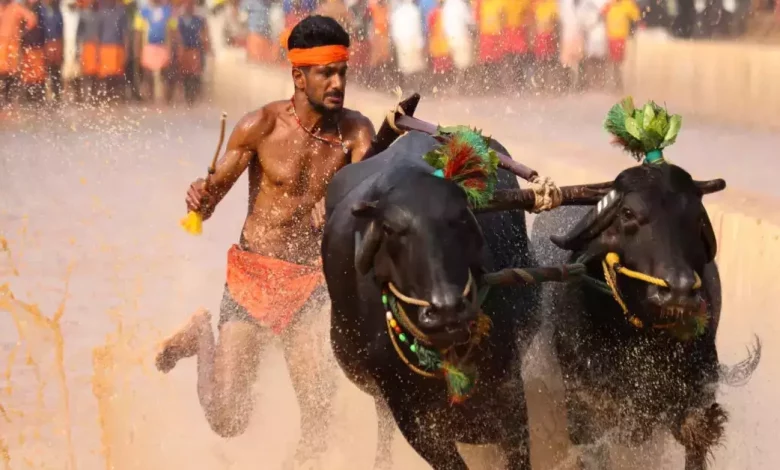
Context- Bengaluru’s first Kambala race was held recently, where 159 pairs of buffaloes and their riders competed on specially prepared mud tracks in the city’s palace grounds.
About Kambala
- About
- It is a folk sport practiced in the coastal regions of Karnataka, especially in areas where Tulu speakers form the majority.
- In the past, different families and groups used to organize competitions in the muddy fields in the days after the rice harvest. Various Kambala samitis or organized bodies now appeared.
- These Samiths organize weekly events from late November to early April in Dakshina Kannada and Udupi region.
- A matter of pride, Kambala is a matter of values for many families, especially the coastal Bunt community.
- They take care of one pair of buffaloes throughout the year, hoping to win the Kambala event.
- Categories in Kambala:
- It is usually divided into four categories.
- The first is Negilu (plough), where light plows are used to drive buffaloes.
- The event is aimed at entry-level animals.
- Another is Hagga (rope), where jockeys race a buffalo using only a rope to tie the pair together.
- The third class is the Adda Halage, where jockeys stand on a horizontal board pulled by buffaloes.
- So unlike Hagga and Negil, where the jockeys run behind the animals, here the buffaloes drag the riders.
- Kane Halage is the fourth grade where a wooden plank is tied to the buffaloes.
- The board the riders stand on has two holes from which water spurts out when you drag the board along the mud.
- The height of the water spray determines the winner of the event.
Why did the Supreme Court ban Kambala?
-
- Several organizations, including People for the Ethical Treatment of Animals (PETA), launched a petition against all traditional sporting events, complaining about animal abuse.
- Complaints have been made to ban Kambala that the noses of the buffaloes are tied with a rope and the animals are constantly whipped while running, which is cruelty.
- SC decision
-
- After hearing the petitions, the SC in 2014 decided to ban Jallikattu, Kambala and bullock carts.
- Jallikattu, also known as eruthazhuvuthal, is a bull taming sport traditionally practiced in Tamil Nadu during the Pongal harvest festival.
- The ruling also stated that cattle racing violates Section 3, Section 11 (1) (a) and (m) of the Prevention of Cruelty to Animals Act 1960.
- These sections deal with the responsibilities of those responsible for animals and define animal cruelty.
How was the ban lifted?
- MoEFandCC Notification 2016 To Allow Jallikattu, Kambala and Bullock Cart Races in Rest of India In January 2016, the Ministry of Environment, Forestry and Climate (MKM) published an announcement prohibiting the presentation or training of bulls as show animals.
- However, there was an exception to the announcement.
- The exemption specified that bulls can still be trained as show animals in various events such as Jallikattu in Tamil Nadu and Bullock Cart Races in Maharashtra, Karnataka, Punjab, Haryana, Kerala and Gujarat according to the customs and cultures of different communities.
- This exemption was subject to certain conditions aimed at reducing the suffering of animals used in such sports.
Amendments made by the state governments
- At the same time, state governments changed provisions of the Prevention of Cruelty to Animals Act to exempt these incidents.
- Although challenged, a five-judge constitution bench accepted the amendments made by Karnataka, Tamil Nadu and Maharashtra in May 2023.
Why was Kambala accused of caste discrimination?
- Historically, members of the Koraga community, once considered untouchables, were treated badly before the festival began and some were even forced to race instead of buffaloes.
- Even today, critics argue that the sport is dominated by dominant caste groups while lower caste spectators do menial jobs during the event.
Source: Indian Express





.png)



